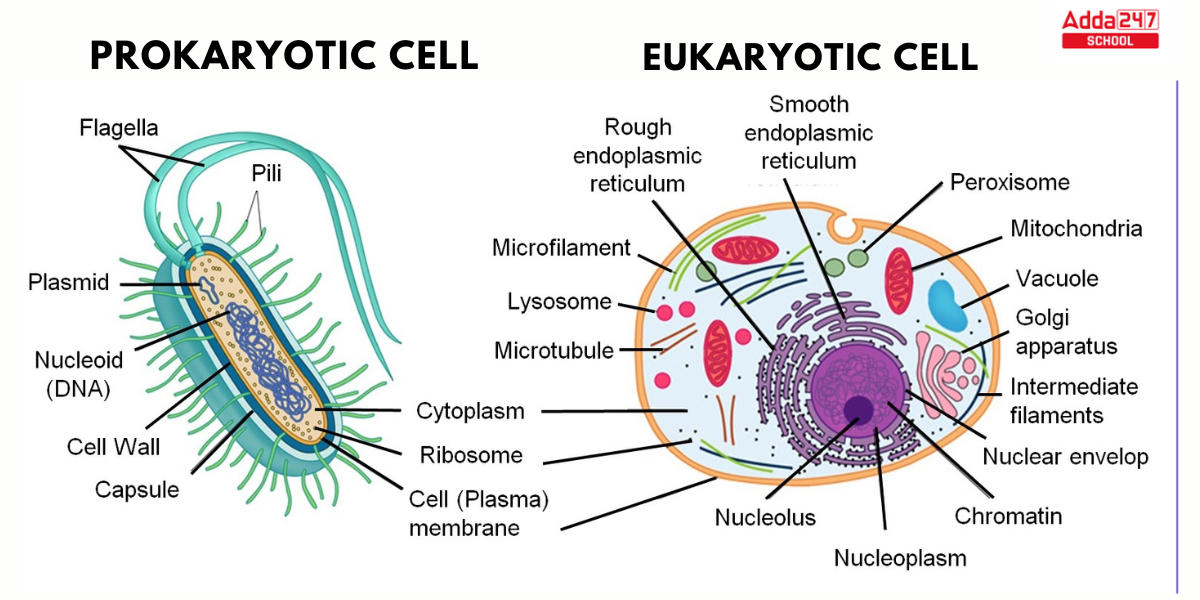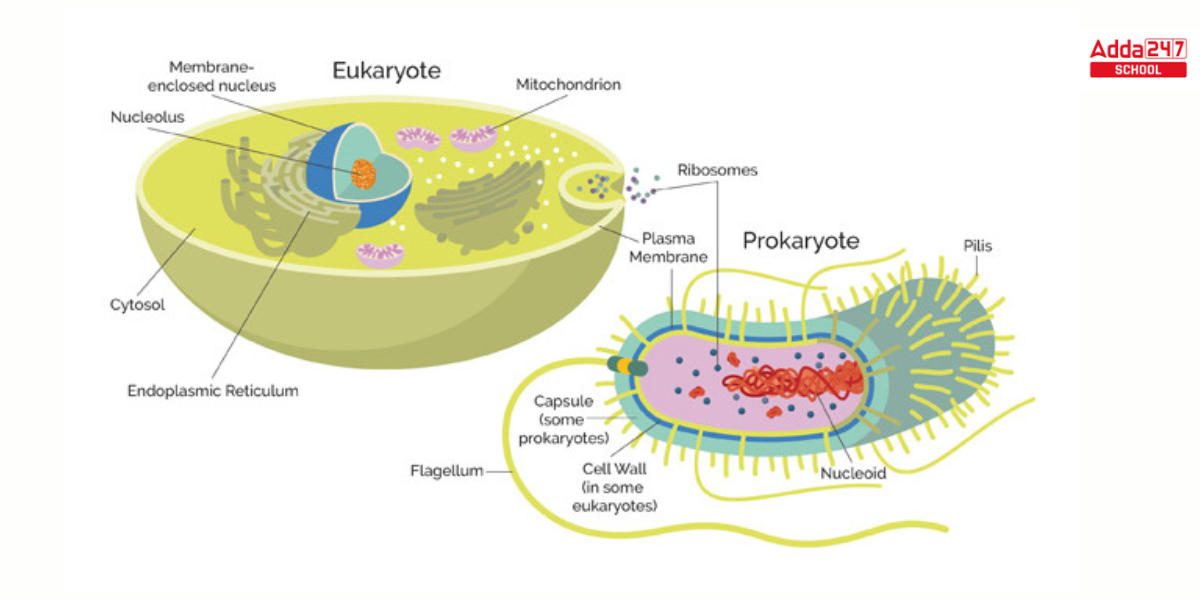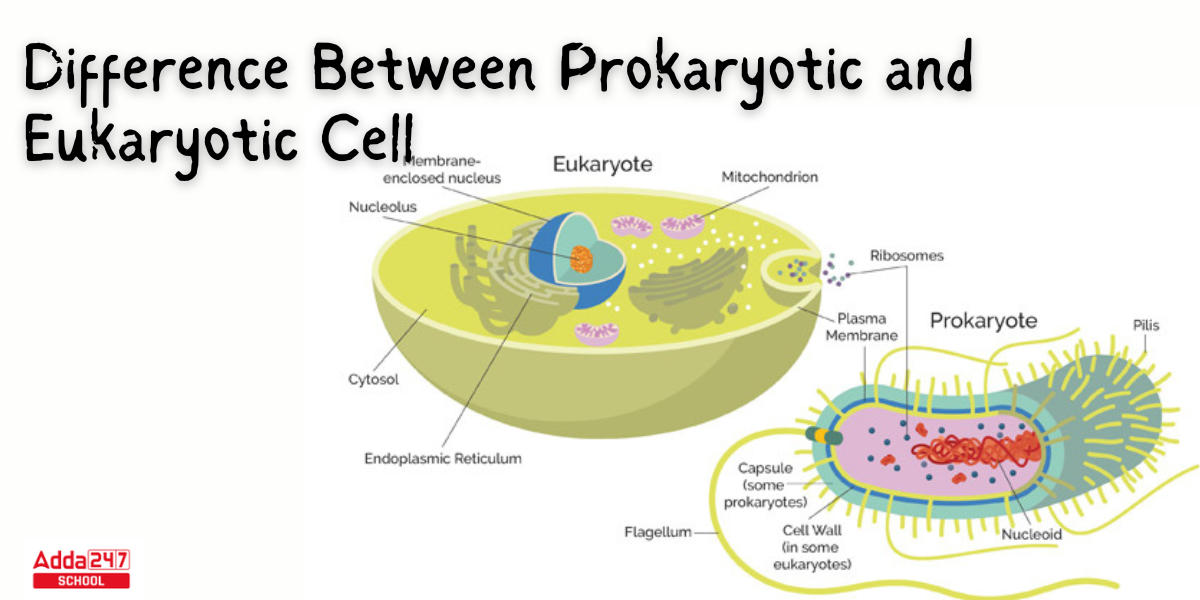Table of Contents
Difference Between Prokaryotic and Eukaryotic Cell: Every living entity, from tiny microbes to massive animals, is made of the same cell. An organism has two types of cells, Eukaryotic and Prokaryotic, based on the internal structure of the cell. The cellular structure of an organism defines which category it belongs to.
Prokaryotic cells are smaller and simpler, whereas eukaryotic cells are more sophisticated and larger. Understanding the Differences between Prokaryotic and Eukaryotic cells is critical to comprehending living organisms. In this post, we shall define prokaryotes and eukaryotes and discuss the distinctions between the two. So read the entire article, and if you still have queries, leave them in the comments section.
Difference Between Prokaryotic and Eukaryotic Cell
The cell is the fundamental unit of life and serves as the foundation for all living beings.
- Single-celled organisms or unicellular organisms are those made up of a single cell, while multi-cellular organisms are those made up of more than one or many cells.
- Robert Hooke discovered the cell in 1665. Scientific and technological breakthroughs have cast more light on the cell, with fresh findings and discoveries concerning its structure and its components. Scientists proposed the concept of prokaryotic and eukaryotic cells in the 1950s, with Edouard Chatton, a French biologist, laying the groundwork in 1925.
- Difference Between Prokaryotic and Eukaryotic Cell: Because cells differ in terms of classification, prokaryotic cells, and eukaryotic cells differ fairly significantly. Prokaryotic cells are primitive cells found primarily in single-celled organisms, and they lack a nucleus, instead containing a fragment of DNA and the organelles are not bounded by membranes, whereas eukaryotic cells are found in all types of multicellular organisms, including plant and animal cells, and they have a nucleus and organelles that are surrounded by membranes.
What is a Prokaryotic cell?
Knowing what is a prokaryotic cell is very important to understand the Difference Between Prokaryotic and Eukaryotic Cell. Here we have compiled some features of the prokaryote cells.
- Unicellular beings known as prokaryotes are notable for lacking membrane-bound components and the nucleus. Prokaryotic cells lack membrane-bound structures but do have discrete cellular areas.
- DNA binds together in an area known as the nucleoid in prokaryotic cells.
- Prokaryotes are classified into two groups: bacteria and archaea.
- Protein, DNA, and metabolite molecules can all be found floating in the cytoplasm of prokaryotes.
- Bacterial primitive organelles function as micro-compartments to provide some feeling of order to the arrangement.
- Example – Bacteria and archaea.

Image – Difference Between Prokaryotic and Eukaryotic Cell
What is a Eukaryotic cell?
Eukaryotes are larger and more complicated than prokaryotes.
- Eukaryotes are organisms with cells that contain a nucleus and other organelles that are surrounded by a plasma membrane.
- Except for Kingdom Monera, they include practically all of the main kingdoms.
- Eukaryotes have a cell wall, which supports and protects the plasma membrane. The plasma membrane surrounds the cell and regulates the entry and exit of many chemicals.
- DNA, which is accountable for preserving all genetic data, is found in the nucleus. The nuclear membrane encircles the nucleus. The nucleolus is found within the nucleus.
- Eukaryotic cells also have mitochondria, which are in charge of producing energy, which is then used by the cell.
- Chloroplasts are photosynthetic subcellular locations found solely in plant cells. The endoplasmic reticulum facilitates material movement.
- Other cell organelles that serve different activities include ribosomes, lysosomes, Golgi bodies, cytoplasm, chromosomes, vacuoles, and centrosomes.
- Examples – animals, plants, fungi, algae, and protozoans.
Difference Between Prokaryotic and Eukaryotic cell with examples
Prokaryotes were the first living organisms. Eukaryotes are thought to have originated from prokaryotes some 2.7 billion years ago, according to scientists. The main Difference Between Prokaryotic and Eukaryotic cells is that eukaryotic cells have a membrane-bound nucleus, whereas prokaryotic cells have not. Both prokaryotic and eukaryotic cells, for example, have cell membranes and ribosomes, but the similarities end there. Now, look at the table below to see how Prokaryotic and Eukaryotic Cells vary.

| Difference Between Prokaryotic and Eukaryotic Cell | ||
| Particulars | Prokaryotic cells | Eukaryotic cells |
| Type of Cell | unicellular |
Eukaryotic cells are either unicellular or multicellular.
|
| Size of Cell | 0.2 μm – 2.0 μm in diameter |
Size ranges from 10 μm – 100 μm in diameter
|
| Nucleus | In this Prokaryotic cell, the true nucleus is absent, instead, the nucleotide is present |
The true nucleus is present.
|
| Cell wall | the cell wall is present and it is very complex in nature |
cell walls found in very rare cases, if present they have simple chemical nature.
|
| Mitochondria | Mitochondria is absent |
Mitochondria is present
|
| DNA structure | DNA is arranged in a circular shape | linear in shape |
| Cytoplasm | the cytoplasm is present, but it is absent in most cell organelles |
eukaryotic cells consist of both cytoplasm and organelles.
|
| Vacuoles | Vacuoles absent | Vacuoles present |
| Ribosomes | Ribosomes are present, small in size, and spherical |
present, comparatively large and linear in shape
|
| Endoplasmic reticulum | The endoplasmic reticulum, lysosomes, centromere all are absent |
The endoplasmic reticulum, lysosomes, and centromere all are present.
|
| Plasmids | Plasmids are commonly found in prokaryotic cell |
Plasmids are very rarely found in eukaryotes
|
| Cell Division | Cell division occurs through binary fission |
Cell division occurs through mitosis
|
| Pili and fimbriae | It may have pili and fimbriae. |
Pili and fimbriae are absent
|
| Flagella | Flagella is small in size |
If flagella are large in size.
|
| Reproduction | only asexual reproduction occurs |
Both sexual and asexual reproduction occurs.
|
| Transcription | Transcription occurs in the cytoplasm |
Transcription occurs inside the nucleus.
|
| Example | Bacteria and Archaea are examples. |
Protists, Fungi, Plants, and Animals
|
Other Related Posts –



 NEET UG 2025: Is NEET Previous years Que...
NEET UG 2025: Is NEET Previous years Que...
 JEE Mains Session 2 Result 2025 OUT, Sco...
JEE Mains Session 2 Result 2025 OUT, Sco...
 TS Inter Results 2025 Date for TSBIE 1st...
TS Inter Results 2025 Date for TSBIE 1st...

